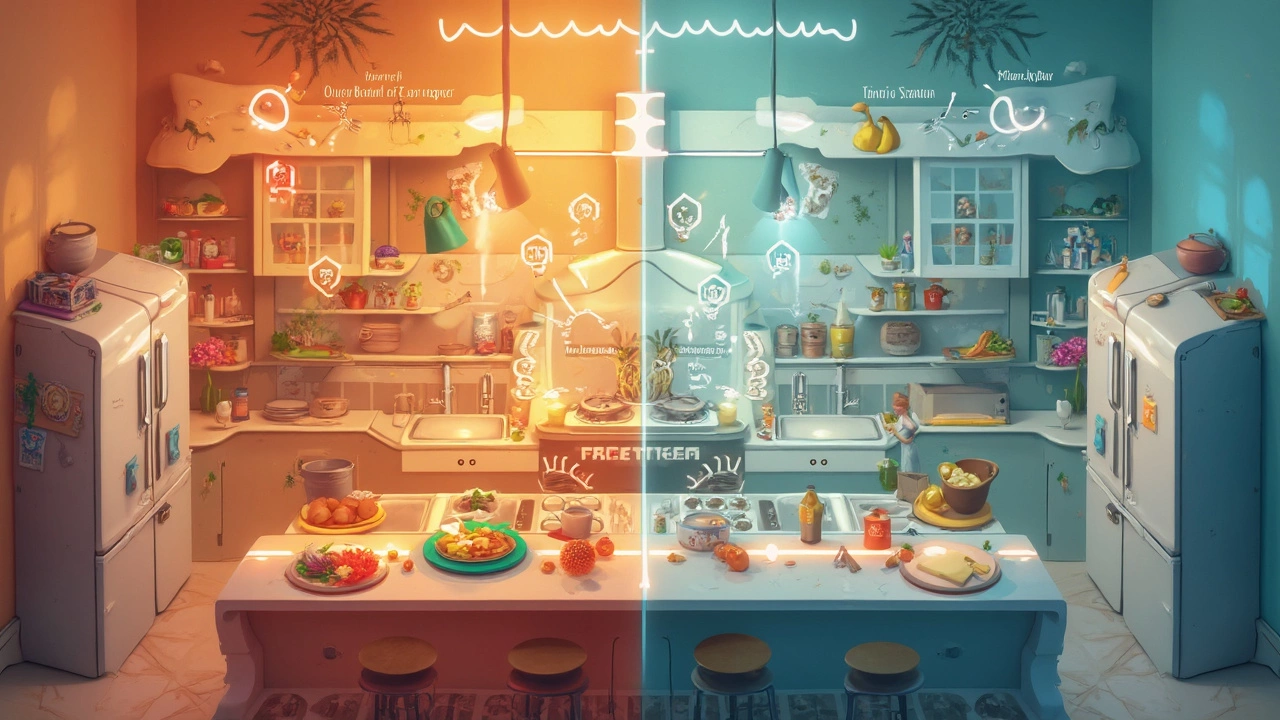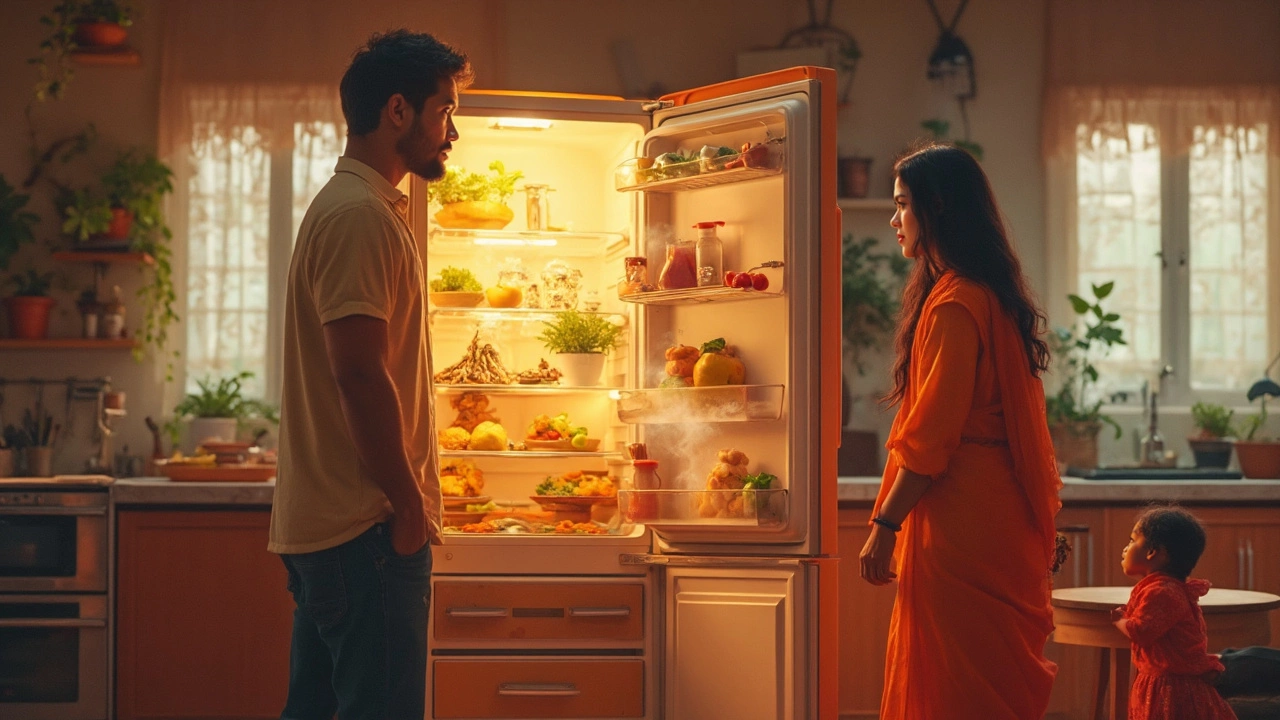Ever thought of squeezing your fridge right up next to your stove? It sounds super convenient—quick grab from the fridge, straight to the frying pan. But this classic move isn't as harmless as it seems. Appliances don't always play nice together, and your electric bill might feel the pain before you do.
If your kitchen is tight, it's tempting to combine everything. But sticking your fridge right by a heat source like a stove? That's a recipe for extra wear on your appliances. Your fridge works harder to stay cool, and you'll probably notice a little spike in energy costs. Plus, repairing or replacing tired-out appliances can get real expensive, real quick.
But hey, not everyone has an open-plan kitchen with endless counter space. You've got to work with what you have. So, if you're battling a tiny kitchen or an awkward layout, stick around—you'll want to know the smart shortcuts that pros and home cooks use to dodge problems and still keep the kitchen workflow smooth.
- Why People Often Put the Fridge Next to the Stove
- What Actually Happens: Heat, Energy, and Wear
- Design Hacks to Make It Work
- Expert Tips: Planning a Smarter Layout
Why People Often Put the Fridge Next to the Stove
If you’ve lived in a small apartment or an old house, you’ve probably seen the fridge right up against the stove. Turns out, there are some real-world reasons for this layout—even if it makes kitchen experts cringe.
The main reason? Space and convenience. Not everyone has a huge kitchen. In tighter spots, the fridge and stove end up side by side just to make everything fit. Sometimes, when kitchens are designed or remodeled on a budget, the people doing the work simply put appliances wherever there’s an outlet or water line. City apartments, old homes, or quirky rentals all have this issue.
Another reason is habits. Quick access matters when you’re moving between cooking and grabbing ingredients. Some folks feel it’s easier to keep the 'cooking zone' together—fridge, stove, and sink within arm's reach. This setup matches the 'kitchen work triangle,' a popular design idea since the 1940s. The triangle’s supposed to make food prep smoother and quicker. When space gets pinched, people cut corners—literally.
Home builders and landlords sometimes aren’t thinking long-term. Their goal is to get a working kitchen with minimal fuss, and that often leads to putting the major appliances next to each other, even if it’s not ideal.
Some quick numbers so you see how common this is:
| Type of Home | Kitchen Size (avg sq ft) | % with Fridge Next to Stove |
|---|---|---|
| Urban Apartment | 100-160 | 36% |
| Older Suburban Home | 150-220 | 17% |
| Newly Built Home | 225+ | 7% |
So, while it’s hardly “designer approved,” people jam the fridge and stove together every day, mostly for pure practicality. If you’re wondering about the real fallout of this, keep reading—it gets interesting.
What Actually Happens: Heat, Energy, and Wear
When you park your fridge right next to your stove, heat becomes the main troublemaker. Think about it: stoves get hot, fridges need to stay cold. The closer they sit together, the more your fridge has to work to fight off the heat drifting from the stove (and even from your oven when it’s running).
This constant battle means your fridge compressor has to run more often. According to appliance engineers, every time heat from outside creeps in, your fridge has to kick into high gear to pull the inside temperature back down. Not only does that use more electricity, but it also cranks up the wear and tear on the fridge parts. Some brands warn that a fridge running hotter than its design can cut its lifespan by up to 25%.
You’ll want to see what that can really mean for your wallet and your appliances. Check out the numbers below—it’s more than pocket change:
| Situation | Average Energy Use/Year (kWh) | Expected Appliance Lifespan |
|---|---|---|
| Fridge 12+ inches from stove | ~450 | 14 years |
| Fridge right next to stove | ~600 | 10-11 years |
That’s about 33% more energy burned up each year, just from cramming those two together. Your electric bill quietly creeps up, and your kitchen might feel warmer too. If you cook a lot (or like me, have a dog who’s constantly looking for dropped snacks behind appliances), this extra heat can make the kitchen uncomfortable and put more strain on everything near the stove.
- More cycling for the fridge means noisier operation and even more power pulled from the wall.
- You’ll probably see more food spoil if your fridge struggles to keep temperature steady.
- If there’s no buffer between stove and fridge, cleaning can get harder too—heat bakes goo onto surfaces, and crumbs love tight spaces.
The refrigerator next to stove setup might seem okay at first, but over time, the little problems add up. So if you have a choice, give these appliances some breathing room. If you’re stuck with them side by side, stick around—there are workarounds coming up next.

Design Hacks to Make It Work
So, you’re low on space and your fridge is destined to sit beside the stove. It’s not the end of the world—just a design challenge. With the right tweaks, you can keep your kitchen running without the hassles that usually come with this setup. Here's what actually helps:
- Add a Buffer Zone: Stick something between your refrigerator and the stove, even if it’s just a slim cabinet, a cutting board rack, or a slice of countertop. Even 3–6 inches goes a long way in keeping heat from the stove out of the fridge’s cooling system.
- Insulate the Gap: If there’s zero room for a buffer, get creative. Heat-resistant boards—available at most home centers—slide right between the two to block some of that hot air. A stainless steel panel or a special insulation mat works too.
- Monitor Temperatures: You can buy stick-on fridge thermometers for just a few bucks. Place one near the "stove side" of the fridge interior. If you notice a temp spike after cooking, that side is feeling the heat. This heads-up gives you time to adjust before anything spoils.
- Help Airflow: The fridge’s vent should stay clear of pots, pans, and walls. Otherwise, you’re trapping heat. Leave a small gap behind and beside the fridge to help it breathe.
- Pick the Right Model: If you’re shopping for a new fridge, go with a model that has good insulation or one with side panels designed to deal with higher temperatures. Some brands actually test for this in their specs—look for “climate class” ratings if you really want to geek out.
Just for perspective, here’s a quick peek at how much heat from a stove can force a fridge to work harder, which touches your pocketbook, too. Check this table out:
| Distance Between Fridge & Stove | Average Monthly Energy Cost Increase | Risk of Appliance Breakdown (in 5 years) |
|---|---|---|
| Right next to each other (0 inches) | $5–$8 | High (up to 25%) |
| Separated by 6 inches | $2–$3 | Medium (about 12%) |
| Separated by cabinet (12+ inches) | Negligible | Low (<5%) |
A little distance or insulation pays off in the long run. Another pro tip? If you cook a ton of high-heat dishes, try using your range's back burners when the fridge is nearby—the heat is less intense on the sides that matter. And don't forget to clean the sides and vents about once every season; dust and grease just make the problem worse.
None of this is fancy. Most fixes cost less than dinner out and take an hour or two tops. And you get a refrigerator next to stove setup that actually works for you, not against you.
Expert Tips: Planning a Smarter Layout
When it comes to kitchen design, layout mistakes happen. Too often, people shove the fridge and stove together just to save space. But, kitchen pros have learned a few smart tricks that can make a world of difference—even in a snug apartment kitchen. So, what do the experts really say?
The golden rule: always aim to separate cold and hot appliances by at least 15-18 inches. Why? Heat from the stove makes the refrigerator next to stove work harder, leading to more frequent breakdowns and wasted energy. If space is really tight, even a small gap (just enough for a cutting board or rolling cart) is better than nothing. And hey, extra counter space never hurts.
- Slip a tall, narrow cabinet or a rolling cart between appliances to break up the heat flow.
- Try to keep the work triangle in mind—fridge, stove, and sink should make a triangle for fastest meal-prep flow.
- If you can’t keep them apart, add heat shields beside the fridge to reflect heat away.
- Don’t block airflow around the fridge—leave an inch or two behind and on the sides for better cooling.
Here’s a quick table showing the impact, based on some real dealer data and appliance manufacturer recommendations:
| Gap Between Fridge & Stove | Estimated Extra Energy Use (Yearly %) | Repair Frequency (Years) |
|---|---|---|
| 0 inches (direct contact) | Up to 25% | 3-4 years |
| 12 inches | 10-15% | 5-6 years |
| 18+ inches | Normal (baseline) | 8-10 years |
The best part? You don’t have to start from scratch. You can add solutions—like a pull-out spice rack or a narrow storage cupboard—to squeeze a few inches of separation between appliances. And if you’re thinking about a full remodel, keep fridge and stove on opposite sides for maximum appliance life and lower bills. It’s all about making the space work for you, not the other way around.


